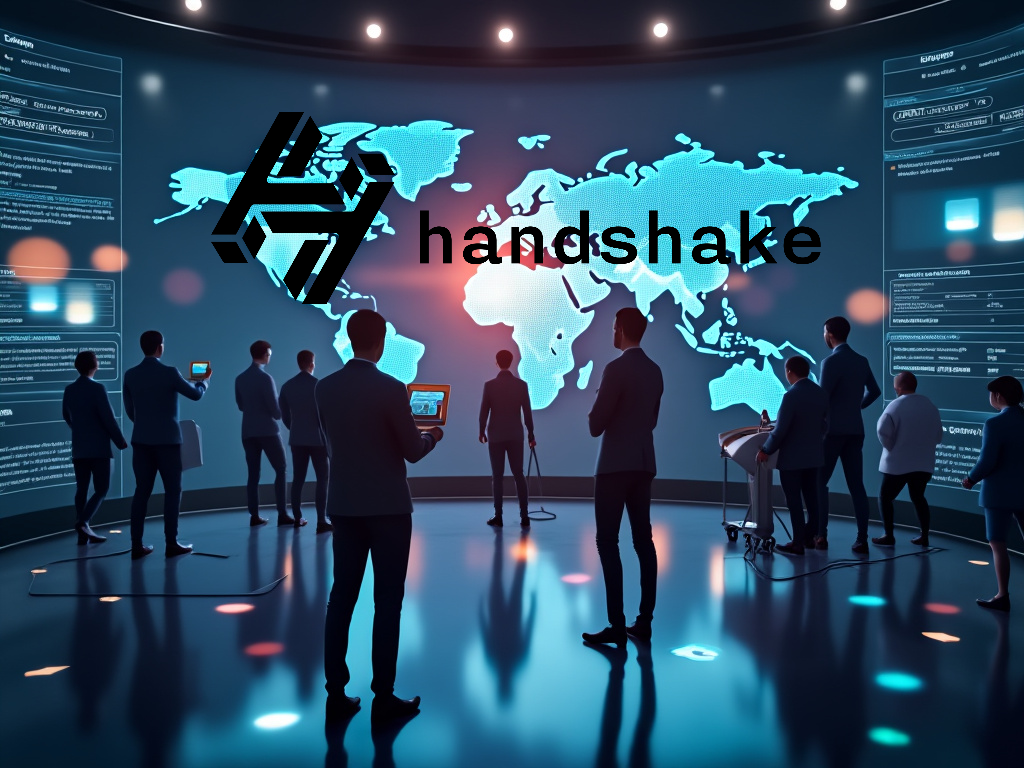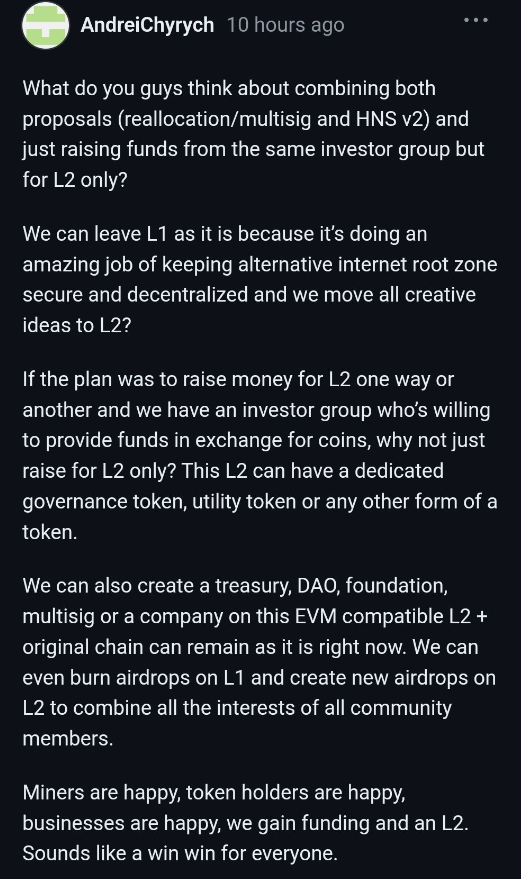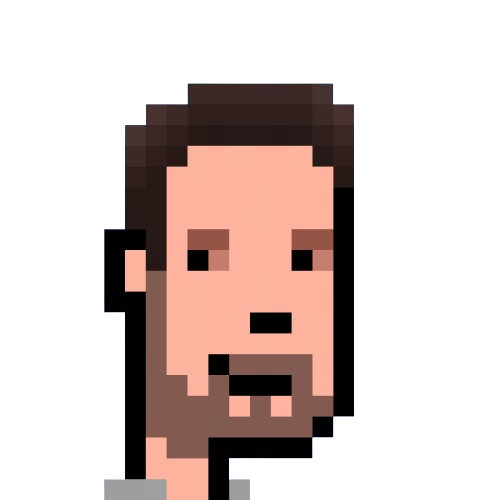7 min to read
Shaping Handshake's Future: Handshake V2, MVG, and L2 Proposals
A Summary of Three Key Proposals for Protocol Enhancement and Governance Over Last Community Call

Handshake Ecosystem: Analyzing Key Proposals and Community Discussions
The Handshake community is currently engaged in discussions about potential changes to its ecosystem, including a possible Hard Fork to address locked developer airdrop allocations. During the latest Discord community call [1], several significant proposals and topics emerged: the “Handshake V2 Proposal” by Nole [2], the “Minimum Viable Governance (MVG)” concept by Papo [3], and discussions around a proposed Layer 2 (L2) solution. This article examines these proposals and their potential impact on the Handshake community.
Current Challenges in the Handshake Ecosystem
Before delving into the proposals, it is important to understand the context around these proposals:
- Core developers like Matt Zipkin and Rithvik had to find full-time jobs outside of Handshake
- There has been a limited awareness about Handshake over the past few years
- Many businesses (such as Impervious) and developers have left due to lack of support and traction
- Existing businesses like Namebase and miners like Bitmain are operating at major losses
- There is still low demand for the $HNS coin
- There is still a lack of major integrations or exchange listings as of 2024
Handshake V2 Proposal (Nole)
Nole’s proposal aims to create a new version of the Handshake protocol (a “Handshake V2”), addressing current challenges and enhancing the network’s capabilities.
Key Features:
- Reallocation of Locked Funds
- Proposes redistributing 890 million HNS from unclaimed developer airdrops
- Allocation breakdown:
- 20% to an HNS V2 entity for coordinating the hard fork and development
- 35% to groups adding value to HNS (e.g., core developers, community contributors)
- 10% to TLDs with SLDs to reward and encourage community building
- 10% to all TLD owners, proportional to the amount burned at auction
- 50% (445 million HNS) reserved for future ecosystem expansion through what Nole calls a “Republic of TLDs”
- Protocol Enhancements
- Development of an HNS native L2 for smart contracts, enabling on-chain SLD mints and TLD token issuances
- Building applications on L2 for social media creators and online communities
- Aim to create more demand for HNS coin through L2 functionality
- Community-Driven Governance
- Emphasizes increased community involvement in decision-making
- Proposes a decentralized governance framework for funding future community development
- Reserve Name Claims
- Unlocking Alexa top 10K and ICANN TLDs for claiming
- Removal of 188 million HNS associated with these names from the total supply
- Ecosystem Development
- Working with browsers and exchanges to integrate Handshake
- Selling a portion of allocated funds to an investor group to raise USD for development
Minimum Viable Governance (MVG) Concept (Papo)
Papo introduced the concept of Minimum Viable Governance (MVG) as a way to establish an efficient and straightforward governance framework for the Handshake community.
Core Principles:
- Governance Simplicity
- Advocates for a minimalistic yet effective governance model
- Aims to create a system for making decisions before implementing major changes
- Focus on Critical Decisions
- Prioritizes governance of essential aspects such as protocol upgrades and fund allocations
- Seeks to create a mechanism for community consensus on important issues
- Gradual Evolution
- Promotes an incremental approach to governance
- Suggests potentially using existing blockchain platforms (e.g., Ethereum or Cardano) for implementing voting mechanisms
- Identity Verification
- Proposes linking Handshake domains to blockchain addresses for voting identity verification
- Aims to prevent Sybil attacks and ensure fair representation in governance
- Separation from Blockchain
- Suggests keeping the governance system separate from the Handshake blockchain to avoid perverse incentives
Proposed Handshake Layer2 (L2) Solution and Community Reactions
Andrei Chyrych, one of Handshake’s most active community members, proposed developing a Layer 2 solution as part of the V2 proposal. However, this aspect of the proposal has been met with significant community debate.
Key Points of the L2 Proposal:
 Andrei Chyrych’s L2 Proposal
Andrei Chyrych’s L2 Proposal
- Purpose
- Intended to create a platform for content creators and influencers to launch community tokens and build membership through SLDs
- Aimed at catching “narrative tailwinds” in the crypto ecosystem and mainstream adoption of creator economies
- Funding
- Suggested using part of the reallocated funds to develop and launch the L2 solution
- Integration with Existing Ecosystem
- Proposed as a way to ensure value created on top of the L2 stays within the Handshake ecosystem
- Aim to create more use cases for HNS coin, including staking for L2 security
- Inspiration from Other Projects
- Mentioned Stacks as an example of a successful L2 on Bitcoin
Community Reactions and Concerns:
- Deviation from Core Vision
- Some community members, including Papo, expressed concern that the L2 proposal deviates from Handshake’s original vision of a decentralized internet and alternative root zone
- Existing Solutions
- Community members pointed out that existing projects (e.g., Nostr, Bluesky) already provide social networking capabilities, suggesting Handshake should integrate with these rather than build its own
- Focus on Core Development
- There’s a sentiment that resources should be primarily directed towards core protocol development and adoption rather than building additional layers
- Governance and Accountability
- Concerns were raised about how the L2 development would be governed and held accountable to the community
- Some members opposed giving funds directly to a VC entity for L2 development
- Market Dynamics
- Discussions around whether focusing on coin price and “narrative tailwinds” aligns with Handshake’s long-term goals
- Integration vs. New Development
- Suggestions to integrate with existing L2 solutions rather than building a new one from scratch
Community Dynamics and Decision-Making Regaring the Proposed Hard Fork
- Founder Involvement
- Andrew Lee, one of Handshake’s founders, clarified that he’s not looking at the proposal to fund his new business, or take control over Handshake, but rather to bing new life and excitment into the protocol
- Offered to transfer control of community assets like the Handshake.org domain, or the @HNS X account, to a decentralized structure
- Consensus Building
- Discussions revealed a split in the community between those favoring significant changes and those preferring minimal alterations
- Notable compromises emerging, such as HNSBroker softening his stance from complete opposition to considering partial reallocation and burning of the unclaimed airdrop
- Transparency and Trust
- Open discussions about the motivations behind proposals and the need for accountability in any new structures
- Balancing Innovation and Core Vision
- Ongoing debate about how to evolve the project while staying true to its original goals of decentralization and censorship resistance
Potential Impact on the Handshake Ecosystem
The proposals and discussions highlight the community’s desire for progress while maintaining Handshake’s core vision. The Handshake V2 proposal by Nole offers technical advancements and fund reallocation, while the MVG concept proposed by Papo envisions sustainable governance for the future of Handshake. The L2 discussion underscores the need for careful consideration of new features and the alignment with Handshake’s original goals. However, the community still thinks that anyone is welcome to work on an L2 solution, but it should not be funded by the reallocated funds.
Conclusion
As the Handshake community deliberates on these proposals, it is clear that there is a delicate balance between innovation and maintaining the protocol’s core principles. The discussions around a Handshake V2, a MVG, and a L2 reflect a vibrant community eager to address challenges and explore new opportunities. While no decision has been made, ongoing discussions will continue to shape the future of Handshake, potentially leading to increased adoption, improved functionality, and a more engaged user base. The community’s ability to have open, constructive dialogues about these complex issues bodes well for the protocol’s long-term sustainability and governance.
References
[1] Dweb Chats #11: Followup discussion on the pros/cons of the proposed reallocation hard-fork
[2] Handshake V2 Proposal
[3] DiscoSolaris’s X
[4] Nole’s X
[5] Andrei Chyrych’s X
[6] HNSBroker’s X
[7] Andrew Lee’s X



Comments